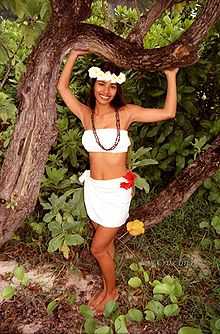
A young woman from Guam.
| Women in society |
|---|
 |
|
|
|
|
|
|
|
|
|
|
 Feminism portal Feminism portal
|
|
Women in Guam, sometimes referred to as Guamanian women or Chamorro (also spelled as Chamoru) women, are women who live in and are from Guam, an unincorporated territory of the United States. By traditionial Guamanian culture, the women of Guam are the managers of family resources such as land and food. At present, women - together with Guamanian men - participate in jobs that belong to the wage economy category; but there are also women - among men - who work in the agricultural sector.[1]
In the culture of the Chamorro people, there had been a balance in the gender roles of women and men. The oldest daughter in the Guamanian family shares power with the oldest son. Women, by tradition, is a powerful figure within the household (men excel in areas of public affairs such as hunting and fishing). The eldest daughter had the responsibility of caring for her parents during their older years.[1]
Guam had undergone change after three centuries of colonialism. While men dominated the political sphere, women became active participants in organizations that are socially, religiously, and culturally oriented. Roman Catholicism also brought change in Guam. One of them is the rendering of "higher status" to the role of men in government, business and church while to women were delegated roles that are related to controlling resources of the family. After the recent half century, some women of Guam experienced being elected as political officials and as leaders in many civic and governmental organizations.[1]
In the common practice of poksai - a form of adoption system in Guamanian society, childess Guamanian women may raise a niece or a nephew, a member of her domestic unit, known as the clan or extended family (the core of Guamanian society).[1]
See also
References
- ↑ 1.0 1.1 1.2 1.3 Hattori, Anne Perez. "Guam". Countries and Their Cultures. Retrieved 6 October 2013.
External links
Culture of indigenous Oceania |
|---|
|
List of resources about traditional arts and culture of Oceania | | | Art | |
|---|
| | Broad culture | |
|---|
| | Geo-specific, general | |
|---|
| | Canoes | |
|---|
| | Dance | |
|---|
| | Festivals | |
|---|
| | Languages |
| by area |
|
|---|
| | by category |
Languages of Oceania |
|---|
|
|---|
| | Literature |
Literature of Oceania |
|---|
| | Sovereign states |
- Australia
- Cook Islands
- Fiji
- Kiribati
- Marshall Islands
- Federated States of Micronesia
- Nauru
- New Zealand
- Niue
- Palau
- Papua New Guinea
- Samoa
- Solomon Islands
- Tonga
- Tuvalu
- Vanuatu
|
|---|
| |
- American Samoa
- Christmas Island
- Cocos (Keeling) Islands
- Easter Island
- French Polynesia
- Guam
- Hawaii
- New Caledonia
- Norfolk Island
- Northern Mariana Islands
- Pitcairn Islands
- Tokelau
- Wallis and Futuna
|
|---|
|
|---|
| | Music | |
|---|
| | Mythology | |
|---|
| | Research | |
|---|
| | People | |
|---|
| | Religion |
Religion in Oceania |
|---|
| | Sovereign states | |
|---|
| |
- American Samoa
- Christmas Island
- Cocos (Keeling) Islands
- Easter Island
- French Polynesia
- Guam
- Hawaii
- New Caledonia
- Norfolk Island
- Northern Mariana Islands
- Pitcairn Islands
- Tokelau
- Wallis and Futuna
|
|---|
|
|---|
|
Not included: Oceanian: cinema, (indigenous) currency, dress, folkore, cuisine. Also see Category:Oceanian culture. |
|

